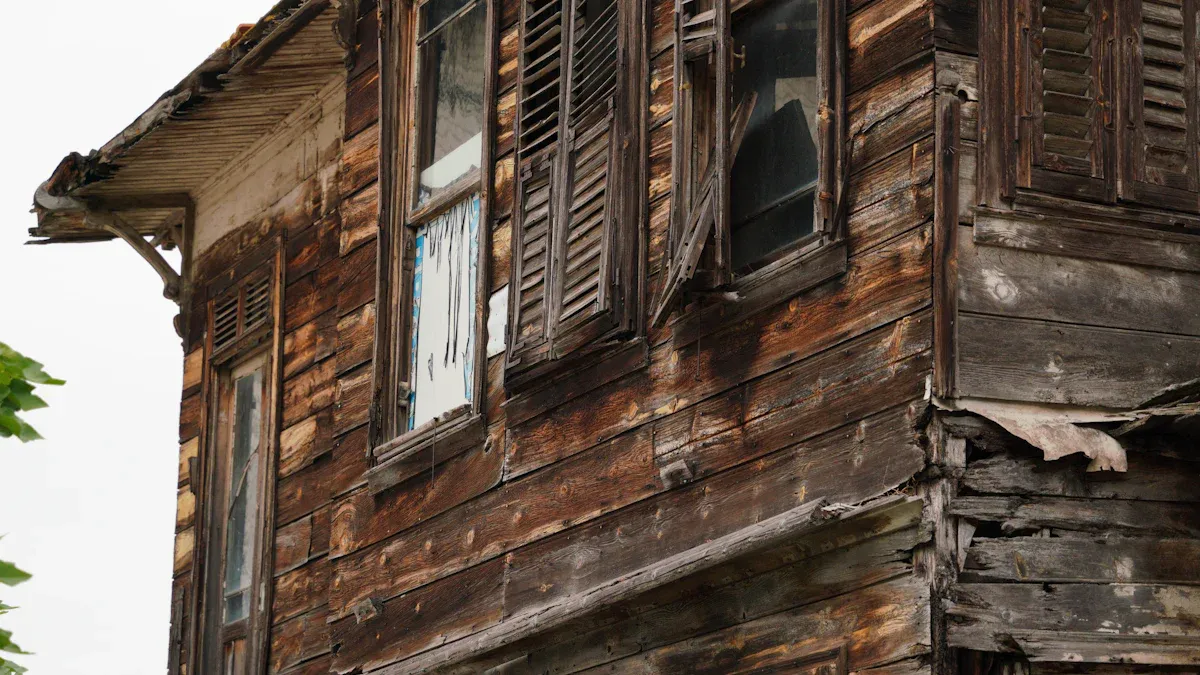Last updated on July 1st, 2025 at 05:51 pm
I picked up “We Have Always Lived in the Castle” on a cold October evening, expecting another standard gothic tale. Three sleepless nights later, I found myself mentally scarred by Shirley Jackson’s twisted masterpiece. This “dark gem” and “deliciously haunting read” follows eighteen-year-old Mary Katherine “Merricat” Blackwood, who lives with her sister Constance in isolation after their family was poisoned six years earlier.
The book caught my attention because of its reputation as “a masterpiece” published just three years before Jackson’s death, and frankly, I needed to understand why critics still call it the gold standard of psychological horror sixty years later.
Jackson crafts an unreliable narrator so compelling that I questioned my own sanity while reading. Her exploration of isolation, persecution, and feminine rage creates a suffocating atmosphere that left me questioning everything about family loyalty and social ostracism. The novel’s continued relevance speaks to Jackson’s ability to tap into primal fears about belonging and acceptance.
Mary Katherine Blackwood narrates this tale of survival and sisterly devotion with chilling detachment. Constance Blackwood remains trapped in domestic routine, cooking elaborate meals for just two people. Their reclusive existence gets shattered when cousin Charles arrives, threatening their carefully constructed world of rituals and superstitions.
Key Takeaways
Jackson’s psychological insight into trauma and isolation remains unmatched in gothic literature, creating characters who feel simultaneously sympathetic and terrifying.
The novel serves as a brilliant critique of small-town persecution and mob mentality, showing how communities create their own monsters through exclusion and hatred.
Merricat’s unreliable narration demonstrates Jackson’s mastery of voice, leaving readers constantly questioning what really happened during the family poisoning.
The house itself functions as a gothic character, with its deteriorating rooms and protective barriers symbolizing the sisters’ psychological state and retreat from society.
Jackson’s exploration of feminine resistance against patriarchal intrusion offers a proto-feminist reading that feels startlingly contemporary even today.
Basic Book Details
- Publishing Information: September 21, 1962 by Viking Press
- Genre: Gothic Fiction, Psychological Horror, Literary Fiction
- Plot: Two sisters live in isolation after family poisoning incident; cousin’s arrival threatens their carefully maintained world
- Series Information: Standalone novel
- Page Count: 214 pages
- Main Characters:
- Mary Katherine “Merricat” Blackwood: Eighteen-year-old narrator with possible involvement in family deaths
- Constance Blackwood: Elder sister who never leaves the house and was acquitted of poisoning charges
- Charles Blackwood: Money-hungry cousin who disrupts the sisters’ isolation
- Uncle Julian: Elderly survivor of the poisoning, confined to wheelchair
Plot Summary And Gothic Foundation
The Blackwood Family Tragedy And Six Years Of Isolation
Jackson’s “entirely unreliable narrator” guides us through a world shaped by tragedy, where the Blackwood sisters exist in self-imposed exile from their hostile village. Six years ago, arsenic-laced sugar killed four family members during dinner, leaving only Merricat, Constance, and wheelchair-bound Uncle Julian alive. Constance faced trial for the murders but was acquitted, though the townspeople never accepted her innocence.
The sisters have created a fortress-like existence in their deteriorating mansion. They venture out only for groceries, enduring the villagers’ whispered accusations and children’s taunts. Jackson masterfully establishes this foundation of isolation and suspicion, making readers feel the weight of social ostracism that drives the sisters deeper into their protective shell.
Merricat’s Ritualistic World And Village Hostility
Merricat has developed an elaborate system of protective rituals and superstitions to keep her world safe. She buries objects, recites chants, and maintains specific routines that she believes ward off danger. These magical thinking patterns reveal a deeply traumatized psyche trying to control an uncontrollable world.
The village’s hostility toward the Blackwood sisters feels palpable throughout Jackson’s prose. Children throw rocks and chant cruel rhymes, while adults whisper and stare with undisguised hatred. This community persecution creates the perfect gothic atmosphere of paranoia and dread that permeates every page.
Character Analysis And Psychological Depth
Mary Katherine Blackwood As Unreliable Narrator And Witch Figure
Merricat functions as one of literature’s most fascinating unreliable narrators, revealing information through what she chooses not to say as much as what she does. Her childlike voice masks a potentially dangerous intelligence, and her attachment to cats, magical thinking, and nature worship positions her as a modern witch figure. Jackson never explicitly confirms Merricat’s guilt in the poisoning, but subtle hints throughout suggest she may have been the actual murderer.
Her psychological complexity emerges through contradictions – she claims to love Constance while simultaneously resenting any threat to their isolation. Merricat’s protective rituals and superstitions reveal a mind trying to impose order on chaos, but also suggest someone capable of extreme measures when that order gets threatened.
Constance Blackwood’s Domestic Prison And Protective Love
Constance represents the perfect domestic woman trapped by circumstance and trauma. She cooks elaborate meals, tends the garden, and maintains household routines with obsessive precision. Her refusal to leave the house stems partly from agoraphobia and partly from the knowledge that the outside world sees her as a murderer.
Her relationship with Merricat reveals the complex dynamics of codependency. Constance protects Merricat from the world’s harsh realities while Merricat protects Constance from having to face uncomfortable truths about their situation. This mutual protection creates a sealed world that becomes increasingly difficult to maintain when outside forces intrude.
| Character Comparison | Merricat | Constance |
|---|---|---|
| Relationship to Outside World | Hostile, protective | Fearful, withdrawn |
| Coping Mechanism | Magical rituals | Domestic routine |
| Psychological State | Potentially dangerous | Traumatized caregiver |
| Role in Family Dynamic | Protector/possible perpetrator | Nurturer/possible scapegoat |
Literary Craft And Writing Style
Jackson’s Masterful Prose Techniques And Atmospheric Building
Jackson was “experiencing extreme agoraphobia at the time of writing” and “struggled to leave her bedroom”, which explains the claustrophobic atmosphere she creates so effectively. Her prose style appears deceptively simple, using short sentences and everyday vocabulary to mask complex psychological insights. This accessibility makes the horror more immediate and disturbing.
Jackson builds tension through accumulation rather than dramatic revelation. She layers small details, subtle contradictions, and atmospheric descriptions until readers feel trapped alongside the characters. Her ability to make ordinary domestic scenes feel threatening demonstrates masterful control of mood and pacing.
Symbolism, Imagery, And The House As Gothic Character
The Blackwood house functions as more than setting – it becomes a living representation of the sisters’ psychological state. As the novel progresses, the house literally crumbles around them, mirroring their increasing isolation from reality. Rooms get sealed off, just as the sisters seal themselves off from difficult truths.
Jackson employs nature imagery to contrast the sisters’ artificial domestic world with the wild, untamed forces Merricat represents. Her attachment to cats, trees, and outdoor spaces suggests a connection to primitive, pre-civilized ways of being that threaten social order. The recurring motif of food and cooking takes on sinister undertones, given the family’s death by poisoning.

Themes And Cultural Commentary
Isolation, Persecution, And The Price Of Being Different
Jackson explores how communities create outcasts and then justify their cruelty by dehumanizing those they’ve rejected. The sisters’ isolation results partly from their own choices but largely from social persecution that makes normal life impossible. This theme resonates particularly strongly in our current era of social media mob mentality and cancel culture.
The novel suggests that being different – whether through suspected criminality, mental illness, or simply refusing to conform – inevitably leads to social exile. Jackson doesn’t romanticize this isolation but shows its devastating psychological costs while also acknowledging the fierce bonds it can create between fellow outcasts.
Feminist Undertones And Patriarchal Resistance In 1960s America
Charles Blackwood’s arrival represents patriarchal intrusion into the sisters’ female-dominated space. His attempts to “normalize” their situation – encouraging Constance to socialize, managing their finances, imposing masculine authority – threaten the alternative family structure they’ve created. Merricat’s violent rejection of his presence can be read as resistance to patriarchal control.
Jackson “freely admitted that the two young women in the story were liberally fictionalized versions of her own daughters”, suggesting personal investment in exploring feminine autonomy and resistance. The novel predates second-wave feminism but anticipates many of its concerns about women’s right to define their own lives outside traditional structures.
| Thematic Analysis | Gothic Elements | Social Commentary |
|---|---|---|
| Isolation | Crumbling house, hostile villagers | Community persecution of difference |
| Feminine Power | Witchcraft imagery, domestic control | Resistance to patriarchal authority |
| Unreliable Truth | Ambiguous guilt, hidden secrets | Questioning official narratives |
| Psychological Horror | Mental deterioration, paranoia | Trauma’s lasting effects |
Pros
Jackson’s psychological insight remains unmatched in gothic literature. Her ability to create sympathy for potentially murderous characters while maintaining moral ambiguity demonstrates rare literary skill. The atmospheric building through seemingly mundane details creates genuine dread without relying on cheap scares or graphic content.
Merricat’s voice captures the complexity of trauma responses with startling accuracy. Her magical thinking, protective rituals, and fierce loyalty feel psychologically authentic rather than merely plot devices. Jackson avoids pathologizing her characters while honestly depicting the costs of severe isolation and social rejection.
The novel’s brevity works in its favor – at 214 pages, it maintains intensity without padding. Every scene serves multiple purposes, advancing plot while deepening character development and thematic exploration. Jackson’s prose style perfectly matches her content, appearing simple while concealing sophisticated literary techniques.
Cons
The novel’s ambiguity, while literarily sophisticated, can frustrate readers seeking clear answers about the poisoning. Jackson deliberately withholds information, which some readers interpret as pretentious rather than artful. The lack of resolution regarding Merricat’s actual guilt may leave thriller fans unsatisfied.
Constance’s passivity can feel frustrating to modern readers, though this likely reflects 1960s gender expectations more than character flaws. Her willingness to remain trapped by circumstances that could potentially be changed may strain contemporary readers’ patience.
The supporting characters remain largely underdeveloped, functioning more as symbols than fully realized people. While this serves Jackson’s thematic purposes, it limits the novel’s emotional range and social complexity.
Performance as Gothic Novel
Genre Context Analysis
| Gothic Convention | Jackson’s Approach | Effectiveness Rating |
|---|---|---|
| Decaying House | Literal and metaphorical decay | Exceptional |
| Family Secrets | Ambiguous guilt and complicity | Superior |
| Supernatural Elements | Psychological rather than literal | Innovative |
| Social Criticism | Class and gender dynamics | Advanced |
| Atmospheric Horror | Psychological rather than physical | Masterful |
Within gothic literature, Jackson’s approach feels both traditional and revolutionary. She employs classic elements – the crumbling mansion, family curses, social persecution – while grounding supernatural suggestions in psychological realism. This creates horror that feels more immediate and lasting than purely fantastical approaches.
Compared to contemporary gothic works, Jackson’s restraint and subtlety stand out. She achieves more terror through implication and atmosphere than most authors manage with explicit content. Her influence on later psychological horror writers like Gillian Flynn and Tana French remains evident in their unreliable narrators and ambiguous morality.
Reader Experience And Accessibility
I read this book during a particularly stressful period, starting it on a rainy Thursday evening when I needed something absorbing. The opening pages drew me in immediately with Merricat’s distinctive voice and her matter-of-fact discussion of her family’s deaths. By midnight, I was completely absorbed in the sisters’ claustrophobic world.
The reading experience feels deliberately uncomfortable. Jackson forces readers to identify with potentially dangerous characters while providing enough ambiguity to question that identification. This psychological manipulation demonstrates her skill but can be emotionally draining for sensitive readers.
Content Warnings for Readers:
- Family poisoning and death
- Mental health issues including agoraphobia
- Social persecution and mob mentality
- Psychological manipulation between family members
- Animal death (brief reference)
Reading difficulty remains moderate – Jackson’s prose style is accessible, but the psychological complexity requires attention. The short length makes it suitable for book clubs, though discussions may become heated given the moral ambiguities involved.

Film Adaptation Analysis and Cross-Media Comparison
The 2018 film adaptation directed by Stacie Passon has received significant critical attention, holding an 87% rating on Rotten Tomatoes, yet many reviewers found it lacking compared to Jackson’s source material. Critics noted the adaptation was “too low-key and repetitive to build suspense”, failing to capture the novel’s psychological intensity.
The film starred Taissa Farmiga as Merricat and Alexandra Daddario as Constance, bringing visual life to Jackson’s characters. However, while the adaptation remained faithful to the source material with dialogue lifted directly from the book, it simplified some of the novel’s ambiguity. The film’s ending wraps up more quickly and definitively, with the book’s biggest “twist” saved for the final scene, whereas Jackson’s original slowly builds to its haunting conclusion.
Historical Context and Jackson’s Personal Struggles During Writing
Understanding Jackson’s personal circumstances while writing “Castle” adds crucial depth to the novel’s themes of isolation and agoraphobia. Jackson was experiencing severe agoraphobia during the writing process and “struggled to leave her bedroom”, directly informing the psychological authenticity of the sisters’ self-imposed isolation.
This biographical context explains the novel’s claustrophobic atmosphere and the convincing portrayal of voluntary withdrawal from society. Jackson’s own struggles with mental health and social anxiety permeate every page, making the Blackwood sisters’ isolation feel lived-in rather than merely literary. The author’s admission that “the two young women in the story were liberally fictionalized versions of her own daughters” suggests personal investment in exploring feminine autonomy.
Jackson completed this novel just three years before her death in 1965, making it a culmination of her literary career and personal understanding of psychological horror. Her meticulous approach to the work, spending more time on it than any other novel, reflects both artistic dedication and personal catharsis through writing about isolation and family dysfunction.
Final Verdict
“We Have Always Lived in the Castle” stands as Shirley Jackson’s crowning achievement, a psychologically complex exploration of trauma, isolation, and feminine resistance that feels as relevant today as it did in 1962. Jackson “worked with great care on this book and spent more time on it than on any other”, and that dedication shows in every carefully crafted sentence.
The novel succeeds brilliantly as both gothic horror and social commentary. Jackson’s ability to create sympathy for morally ambiguous characters while maintaining genuine suspense demonstrates rare literary skill. Her exploration of how communities create and punish their own outcasts resonates powerfully in our current cultural moment.
Reading this book changed my understanding of what psychological horror could achieve. Jackson proves that the most effective terror comes not from external threats but from the realization that the people we trust most may be capable of unthinkable acts. The ambiguity surrounding Merricat’s guilt forces readers to confront their own assumptions about innocence, family loyalty, and moral certainty.
For readers of literary fiction, gothic horror, or psychological thrillers, this book represents mandatory reading. Those seeking clear moral lines or traditional plot resolution should look elsewhere. Jackson offers no easy answers, only the disturbing recognition that sometimes love and hatred become indistinguishable.
It’s a masterpiece that reveals new layers of meaning with each reading, cementing Jackson’s reputation as one of America’s most important horror writers.
Dionysus Reviews Rating: 7/10
Sip The Unknown—Discover Stories You Never Knew You’d Love!
Dionysus Reviews Has A Book For Every Mood
Biography & Memoir
Fiction
Mystery & Detective
Nonfiction
Philosophy
Psychology
Romance
Science Fiction & Fantasy
Teens & Young Adult
Thriller & Suspense
Frequently Asked Questions
Why does Merricat bury objects and perform rituals throughout the book?
Merricat’s protective rituals represent her attempt to control an uncontrollable world through magical thinking. After experiencing the trauma of her family’s deaths, she develops these superstitious behaviors as a coping mechanism to prevent further disasters.
The rituals also suggest deeper psychological disturbance and possible guilt over the poisoning incident, as she tries to ward off consequences for actions she may have taken.
Is Constance actually guilty of poisoning the family or was she framed?
Jackson deliberately maintains ambiguity about the true perpetrator, but careful readers can find clues suggesting Merricat committed the murders. Constance’s protective behavior toward her younger sister, combined with Merricat’s knowledge of deadly plants and her admission that she should have been born earlier to protect Constance, implies she may have poisoned the family to eliminate those who threatened their bond. The legal system acquitted Constance, but the real truth may be more complex.
What does the deteriorating house symbolize in relation to the sisters’ mental state?
The Blackwood house functions as an external representation of the sisters’ psychological deterioration and increasing isolation from reality.
As rooms become uninhabitable and the structure literally crumbles, it mirrors how their connection to the outside world and normal social functioning continues to decay. The house becomes both prison and protection, just like their psychological defense mechanisms.
How does Jackson’s own agoraphobia influence the novel’s portrayal of isolation?
Jackson was experiencing severe agoraphobia during the writing process and “struggled to leave her bedroom”, which directly informed the psychological authenticity of the sisters’ self-imposed isolation.
Her personal understanding of anxiety and withdrawal from social interaction allows her to capture the complex emotions surrounding voluntary and involuntary isolation with remarkable accuracy.
Why does Merricat react so violently to Charles’s presence in their home?
Charles represents multiple threats to Merricat’s carefully constructed world: he brings masculine authority into their feminine space, encourages Constance to rejoin society, and shows interest in the family money.
His presence threatens to break up the exclusive sister bond that Merricat has protected through isolation and possibly murder. Her violent reaction stems from recognizing him as an existential threat to the only relationship that gives her life meaning.









